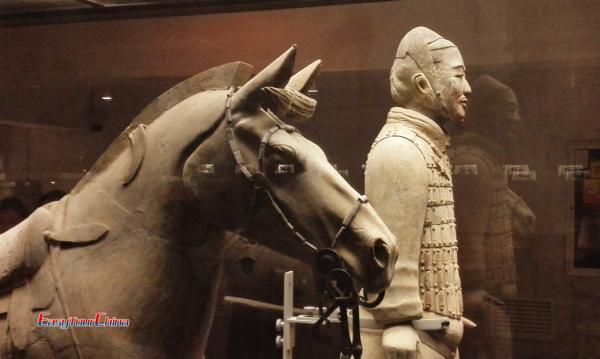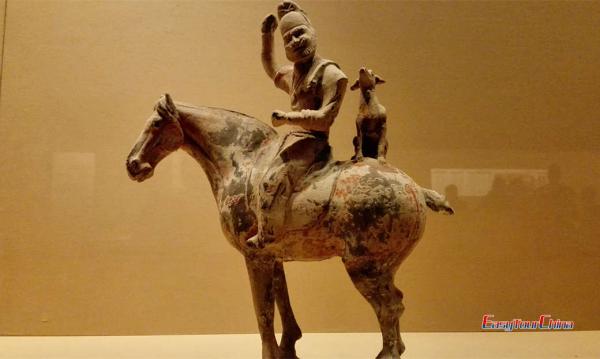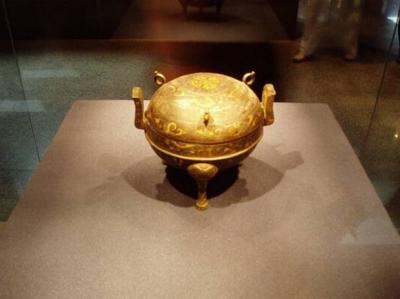Shaanxi History Museum
Located to the northwest of the Big Wild Goose Pagoda in Xi’an, Shaanxi History Museum in Xi’an, China represents a significant milestone as the country’s first large modern national museum. The museum encapsulates the essence of Chinese history; known as the "treasure house of the Chinese nation". This art palace displays the ancient civilization, history, and culture of Shaanxi Province.
Shaanxi History Museum’s collection boasts more than 370,000 cultural relics, ranging from simple stone tools of ancient humans to various implements of social life before 1840, all over a span of more than one million years.
Shaanxi History Museum Facts
- 09:00 – 17:30 (Nov 15th to the next Mar 14th; last entry at 16:00)
- 08:30 – 18:00 (Mar 15th to Nov 14th; last entry at 16:30)

Why You Should Visit Shaanxi History Museum
Shaanxi, especially Xi'an, is the birthplace of Chinese civilization and is one of the most important areas for the further historic development of the Chinese nation. The thirteen most brilliant dynasties in Chinese history, including the Zhou dynasty, Qin dynasty, Han dynasty, and the Tang dynasty, all established their capitals here.
Shaanxi Province contains a rich cultural heritage and profound cultural accumulation, and there is no better place to encounter this history than the Shaanxi History Museum. The Shaanxi History Museum is fittingly known as "the pearl of the ancient capital and the treasure house of the Chinese people", and is a must-see to learn about the history and culture of Shaanxi Province and the ancient Chinese civilization that lived here.
Shaanxi History Museum Architecture
The construction of the Shaanxi History Museum started in 1983 and finished on June 20th, 1991 for its grand opening to the public. The museum has a total area of 65,000 square meters: the building itself encompasses 55,600 square meters, with 8,000 square meters of relic storerooms, 11,000 square meters of exhibition halls, all housing a diverse collection of 370,000 pieces of history.
Shaanxi History Museum boasts a Tang style architecture and organization: the "hall in center” and the “storied buildings in corners.” Elegant and dignified throughout its magnificent scale, Shaanxi History Museum now combines traditional Chinese architecture and modern science to truly embody folk tradition, local feature, and epoch spirit.
Shaanxi History Museum Collections & Exhibitions

The basic exhibition displays the ancient history of Shaanxi. Chronologically organized, it divides this ancient history of Shaanxi into seven parts: Prehistory, Zhou, Qin, Han, Wei, and finally the southern and northern dynasties of Jin, Sui, Tang, Song, Yuan, Ming and Qing. Each period systematically documents the development process of Shaanxi, from the Lantian people of the early paleolithic period to the Opium War. In the basic exhibition of the Shaanxi History Museum, you can explore this period of more than one million years at your own pace.
Special exhibitions in Shaanxi History Museum are unique academic and professional displays, organized around a certain theme. For example, the Tang tomb murals represent one of the most unique and precious collections of this museum, with a total of nearly 600 pieces of murals from more than 20 tombs of Tang dynasty, more than 1,000 square meters in total. Among them, 18 pieces were rated as national treasures by the state, while 82 were rated as first-class products.
Exhibition Hall 1
Exhibition Hall 2
Exhibition Hall 3

Tang Dynasty Mural Treasures Gallery
Tang tomb murals in Shaanxi History Museum provide a glimpse of everyday life during that point in history, including etiquette patterns, living customs, Chinese clothing, and entertainment. They also depict the architectural style of the buildings, simple and vivid characters, and the distinct landscape of lively animals and vivid plants. All these images contributed priceless information for the study of social life in the Tang dynasty, especially regarding aristocratic life and spiritual pursuit.
Best Things to See - The Museum's Most Important Treasures
Gate Tower Ceremonial Procession Painting
The Gate Tower paintings consist of two identical works, each depicting the same scene. They were painted on the east and west walls of the tomb passageway for Prince Yide at Qianling Mausoleum during the Tang Dynasty. The east wall painting measures 304 cm in height and 296 cm in width; while the western painting measures 305 cm in height and 298 cm in width. Crown Prince Yide, Li Chongrun, was the eldest son of Emperor Zhongzong Li Xian and the grandson of Emperor Gaozong Li Zhi and Empress Wu Zetian.
Hunting Procession Painting
This masterpiece among Tang Dynasty tomb murals displayed in Shaanxi History Museum spans 890 cm in total length, with individual sections ranging from 100 cm to 200 cm in height. Against a backdrop of green mountains and pine forests, over forty mounted hunters gallop along the highway outside Chang'an. Some carry bows and arrows, others hold flags or whips for taming leopards. They form a grand procession escorting their master as he rides toward the hunting grounds. The figure on the white horse is likely Crown Prince Zhanghuai, Li Xian.
Gold Bowl with Mandarin Duck and Lotus Petal Design (Two Pieces)
Height: 5.5 cm; Mouth Diameter: 13.7 cm; Foot Diameter: 6.7 cm. These are rare examples of Tang Dynasty gold and silver artistry. The body is fully adorned with a pearl ground pattern. The belly features hammered double layers of upturned lotus petals. The upper layer depicts chiseled mandarin ducks, parrots, wild geese, stork feathers, deer, foxes, antelopes, rabbits, ducks, and other rare birds and beasts; the lower layer features honeysuckle flowers. The interior base is engraved with a lotus flower. The inner wall bears an ink inscription of the weight: “nine liang and three.”
Wusi Wei Ding
Height: 36.5 cm, Mouth diameter: 34.3 cm, Body depth: 19.5 cm, Weight: 11.5 kg. This vessel records a breach-of-contract case between the state of Wei and Prince Li over land compensation, holding significant value for studying Western Zhou legal systems.
Court Ladies Painting
Painted on the south side of the east wall in the antechamber of Princess Yongtai's tomb from the Tang Dynasty. The painting depicts nine figures. Except for two wearing men's robes, the remaining seven are dressed in narrow-sleeved, bare-chested short tunics draped with silk scarves over their shoulders. They wear floor-length skirts in red, yellow, and green hues, with cloud-patterned slippers on their feet, suggesting a scene of attending to the emperor.

How to Get to Shaanxi History Museum?
- By subway: The museum is 778 meters from Xiaozhai Station on Xi'an Metro Lines 2 and 3, and 834 meters from Dayanta Station on Xi'an Metro Lines 3 and 4.
- By Bus: You can take Xi'an Bus Routes 5, 19, 24, 26, 27, 30, 34, 271, 400, 401, 521, 527, or 254 to get to Shaanxi History Museum.
Useful Travel Tips
How to Reserve Shaanxi History Museum Tickets
Reservation Process: Please visit the Shaanxi History Museum official WeChat account and enter the ticket reservation system. Select the date and session, and add your visitor information. After the tickets are released, access the "Plan Inquiry" section and click the "Reserve" button to make a reservation. You may check reservation status under “Order Inquiry.” Each visit plan allows up to 5 visitors, with a limit of 1 ticket per ID/passport number per day.
Cancellation Policy: Cancel tickets via the “Order Inquiry” section on the official booking platform before ticket verification closes for your scheduled time slot. Failure to cancel by the deadline constitutes a no-show. Those who no-show will be barred from booking tickets for 180 calendar days starting from the date of the no-show.
Please note: Seniors aged 65 and above can visit the Shaanxi History Museum without making a reservation. >> Xian Travel Tips for Senior Travelers & Things to Do
Accessible Visitor Pathways and Services
The Shaanxi History Museum provides a range of accessible facilities and signage, including accessible restrooms, accessible parking spaces, accessible pathways, accessible elevators, wheelchair rentals, and Braille labels, to meet the needs of the disabled.


